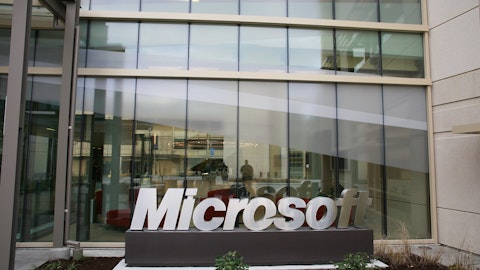Baron Funds, an investment management company, released its “Baron Opportunity Fund” first quarter 2023 investor letter. A copy of the same can be downloaded here. In the first quarter, the fund outperformed the broader market and increased by 17.96% (Institutional Shares) compared to a 13.85% return for the Russell 3000 Growth Index and a 7.50% return for the S&P 500 Index. In addition, please check the fund’s top five holdings to know its best picks in 2023.
Baron Opportunity Fund highlighted stocks like Microsoft Corporation (NASDAQ:MSFT) in the first quarter 2023 investor letter. Headquartered in Redmond, Washington, Microsoft Corporation (NASDAQ:MSFT) is a multinational software company that develops, and licenses software, services, devices, and solutions. On May 9, 2023, Microsoft Corporation (NASDAQ:MSFT) stock closed at $307.00 per share. One-month return of Microsoft Corporation (NASDAQ:MSFT) was 8.29%, and its shares gained 17.83% of their value over the last 52 weeks. Microsoft Corporation (NASDAQ:MSFT) has a market capitalization of $2.283 trillion.
Baron Opportunity Fund made the following comment about Microsoft Corporation (NASDAQ:MSFT) in its Q1 2023 investor letter:
“Shares of mega-cap software and cloud vendor Microsoft Corporation (NASDAQ:MSFT) performed well during the quarter despite mixed fiscal second quarter results. Microsoft’s largest consumer business, Windows licensed to computer vendors, decreased sharply year-over-year as last year’s results were bolstered by pandemic-related purchases. Its key commercial business, reported as Microsoft Cloud, grew 29% on a constant-currency basis, beating Wall Street expectations. Drilling down, its Azure cloud computing business also beat expectations, growing 38% on a constant-currency basis, but growth slowed in December, and management’s forward guidance was for further deceleration to a low 30% level. Since tougher macro trends emerged last year, cloud businesses, like Azure, have faced headwinds from enterprise customers optimizing their cloud workloads and spending, after a brisk pace of expansion over the last two years. Microsoft CEO Satya Nadella addressed this during the last earnings call: “Just as we saw customers accelerate their digital spend during the pandemic, we are now seeing them optimize that spend…. This is an important time for Microsoft to work with our customers, helping them realize more value from their tech spend and building long-term loyalty…. Moving to the cloud is the best way for any customer in today’s economy to mitigate demand uncertainty…while gaining efficiencies of cloud-native development…. I fundamentally believe tech as a percentage of GDP is going to be much higher…on a secular basis…. [W]hat [customers] accelerated during the pandemic, they’re making sure they’re getting most value out of it or optimizing it.… [A]t some point the optimizations will end…[and] the money that they save in any optimization of any workload is what they’ll plow into new workloads and those workloads will start ramping up.” Our research continues to indicate that the long-term secular trend of cloud computing remains healthy and intact and will only be boosted by the AI inflection. Morgan Stanley recently issued a report titled “Cloud Optimization: Short Term Pain for Long Term Gains.” It echoed Nadella’s commentary and our own internal research, concluding that today’s cloud optimization would ultimately yield “higher cloud adoption, upsizing [the] opportunity by 30% longer term.” The key finding of this report, supported by a survey of 80 chief information officers across the U.S. and Europe, was optimization is increasing the expected penetration of the cloud longer term, with 57% of workloads expected to reside in the cloud post-optimization vs. 45% of workloads pre-optimization.
Moreover, we believe Microsoft is positioned to be a prime beneficiary of AI because of its ownership of and partnership with OpenAI, the inventor of ChatGPT; its Azure AI supercomputing cloud infrastructure, which is the exclusive cloud provider to OpenAI and a leading AI development platform for other enterprises; and Microsoft’s own AI innovations across Bing search (a chatbox virtual assistant), GitHub CoPilot software development (automated code suggestions and completion), and its Office suite of worker-productivity software (virtual assistants, branded CoPilot, to draft or summarize an email, enter data into a spreadsheet, prepare slides, etc.). We remain confident Microsoft is well positioned to continue taking share through any economic downturn and emerge stronger on the other side.”

Roman Pyshchyk/Shutterstock.c.om
Microsoft Corporation (NASDAQ:MSFT) holds the first position on our list of 30 Most Popular Stocks Among Hedge Funds. As per our database, 259 hedge fund portfolios held Microsoft Corporation (NASDAQ:MSFT) at the end of the fourth quarter which was 269 in the previous quarter.
We discussed Microsoft Corporation (NASDAQ:MSFT) in another article and shared the list of best socially responsible stocks to buy according to analysts. In addition, please check out our hedge fund investor letters Q1 2023 page for more investor letters from hedge funds and other leading investors.
Suggested Articles:
- 10 Biggest Clothing and Footwear Manufacturers
- 10 Best Scientific Instruments Stocks To Buy
- Top 20 Online Shopping Websites in USA in 2023
Disclosure: None. This article is originally published at Insider Monkey.





